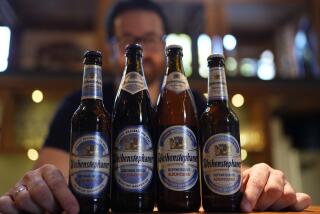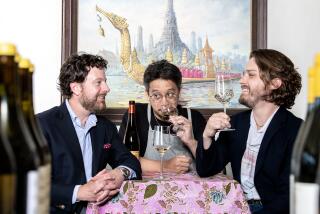A Crowd of Senior Rieslings
Old wines exert as great a fascination for wine lovers as old masters do for art lovers. And when wine enthusiasts think of old wines, it is red Bordeaux that comes to mind first.
The cult that revolves around Bordeaux wines--and the investment market in them--depends on the ability of wines from the top chateaux to age for decades, even (exceptionally) a century or more.
But few wine lovers are aware that some white wines can also grow old gracefully and that many of the longest-lived white wines come from Germany. Late-harvest German Rieslings of 25 or more years of age marry richness and subtlety. The fruity aromas of youth slowly transform into mellow honeyed, waxy, resiny and minerally notes as the wine ages (the higher the quality of the wine, the longer this process takes). These undiscovered vinous treasures have the added attraction of being more moderately priced than Bordeaux wines of comparable age.
The problem is that there are few opportunities to taste really mature German wines. A recent tasting of German dessert Rieslings extending to the legendary 1893 vintage set out to change this and to prove what extraordinary aging potential the best examples of this style possess.
The tasting was staged by the Bremer Ratskeller, a wine company founded almost six centuries ago and still owned by the town of Bremen in northern Germany. The ratskeller has a remarkable collection of rare old German wines going back to the 17th century in its schatzkammer (treasury cellar).
“So many of the old wines opened at rarities tastings are simply liquid antiques,” director Karl-Josef Krotz said. “I wanted to stage a tasting of German Rieslings going back a century, which are still delicious to drink rather than tasting of dust and decay. The 350th anniversary of the town’s political independence seemed an appropriate occasion.” (Bremen purchased its freedom from Kaiser Ferdinand 3rd of Austria in 1646 for 100,000 gold marks, the equivalent of several hundred million dollars today.)
For a long afternoon in early June, 25 experts and journalists from all over Europe sat in respectful silence in the Wilhelmine grandeur of the kaisersaal (kaiser’s room) beneath the town hall of Bremen.
The near-silence was broken only when the oldest of the 45 wines tasted, the 1893 Erbacher Marcobrunn Beerenauslese from Schloss Reinhartshausen in the Rheingau town of Erbach, was served. Gasps of amazement and a buzz of excitement went around the room as one by one the tasters realized how astonishingly fresh and vigorous the wine was at 103 years of age.
Its bouquet of honey and peaches showed none of the usual signs of age you expect in centenarians, and the balance of acidity and luscious fruit in the mouth was exactly what you hope for from a great German Riesling.
Many of those present remarked that it could easily be mistaken for a 20-year-old wine. Clearly, Thomas Jefferson knew what he was talking about when, just more than a century before this wine was made, he recorded in his travel diary that the wines from the Marcobrunn vineyard were the Rheingau’s finest.
All the wines shown at the tasting were late-harvested Rieslings from the Rhine, Mosel and Main valleys. The recorded history of the Riesling grape in Germany goes back to the 15th century; it was with the discovery at the end of the 18th century that late picking resulted in natural dessert wines, however, that it established itself as the dominant grape for quality wine production.
By the middle of the 19th century, German Riesling was the most fashionable and expensive white wine around the world, even out-pricing French wines on the lists of top Parisian restaurants. Not until the over-commercialization of German wines in the 1970s and ‘80s did its reputation slip.
A number of long-established estates and a group of new star winemakers still gain high prices for their top wines, however, and are regularly sold out. It is a little known fact that the 1989 Riesling trockenbeerenauslese from Egon Muller-Scharzhof of Wiltingen in the Saar holds the world record for the most expensive young wine, selling for $2,105 a bottle at an auction in Trier in 1994, the only commercial offering of this wine.
In contrast to Sauternes in Bordeaux, where the dessert wines carry merely the name of the property and vintage, German vintners sell their dessert wines with vineyard designations and classify them according to their richness. An admirable idea, but the result is a thicket of German names that confuse many innocent consumers.
The lowest grade of late-harvest wines is spatlese, where the grapes have been merely picked later for extra ripeness and concentration of flavor.
Then come, in ascending order of richness and density: auslese, beerenauslese, eiswein and trockenbeerenauslese. Except for eiswein, these wines are all made from selectively picked grapes affected by the Botrytis cinerea fungus, the “noble rot” that concentrates and enriches the grape juice.
Auslese, for instance, is made from selected bunches with some botrytis, while trockenbeerenauslese is made from individual berries that have shriveled to a raisin-like state. Eiswein, or ice wine, is made from grapes that are picked and pressed when frozen.
*
German wine law forbids any artificial assistance to either of these natural concentration processes. The production of these wines is therefore a risky business that requires the right weather conditions and great dedication. Hence the rarity and high prices of the wines from the top grades.
The Bremen tasting was divided into two parts, first 22 spatlese and auslese wines, then 23 beerenauslese, eiswein and trockenbeerenauslese. Among the many excellent wines in the first half of the tasting, two were particularly remarkable. The 1921 Kiedricher Berg Auslese from the Robert Weil estate in Kiedrich in the Rheingau was a timeless wine. The peachy fruit and elegant acidity of this wine were reminiscent of others in the tasting 40 or 50 years its junior.
The greatest auslese was the 1949 Wehlener Sonnenuhr from J.J. Prum from Wehlen in the Mosel; it was very succulent and rich, the aftertaste astonishingly long. Auslese wines of recent top vintages (e.g., 1995, 1993 and 1990) from estates such as these will also age magnificently and are comparatively affordable. Prices begin at about $30.
Even as young wines, the Rieslings in the second half of the tasting are certainly not moderately priced, nor were they easy to obtain. Top-grade Riesling dessert wines are invariably made in very small quantities, since the shriveled botrytized grapes contain so little juice. More than 50 cases of such a wine is possible only for eiswein.
*
Still, one wine in the Bremen tasting proved that Riesling eiswein can be among the greatest of all dessert wines. The 1983 Oberhauser Brucke from the Donnhoff estate in Oberhausen on the Nahe (an important tributary of the Rhine) had an incredibly intense flavor of ripe apricots, with toast and mineral overtones. Ice wine can have a dominant sweet-sour character, but this wine had perfect balance for long aging.
There were so many astonishing trockenbeerenauslese wines at the tasting that it is difficult to pick out the best. Trockenbeerenauslese (the seven-syllable name is often abbreviated to TBA) is the pinnacle of German Riesling. Wines like the 1949 Schlossbockelheimer Kupfergrube TBA from the State Domaine of the Nahe are as concentrated in aroma and flavor as wine gets. The bouquet was unique, reminding me of a forest after rain. It was a wine of gigantic stature and power, with intense caramel and spice flavors that took minutes to fade after the wine was swallowed.
If it was the ultimate in power, then the 1937 Rudesheimer Berg Bronnen from Schloss Groenesteyn in Kiedrich was the ultimate in elegance. It was much paler in color than the 1949 TBA--a pale gold instead of a deep amber--and its vibrant dried peach and apricot character was astonishingly vivid, considering its almost 60 years of age.
There is a healthy market for wines of this kind in Germany, and at auctions they often fetch very high prices. The last bottle of the 1893 tasted in Bremen to change hands did so for $8,645.
In America and Britain (where Sotheby’s and Christie’s hold regular wine auctions), however, mature late-harvest Riesling wines often sell at bids that are a tiny fraction of this. If you are looking for that anniversary bottle (1937 and 1947 were both excellent vintages, 1957 good but rare), late-harvest German Rieslings could well offer the most affordable solution. It might also be the most delicious way to celebrate.
More to Read
Eat your way across L.A.
Get our weekly Tasting Notes newsletter for reviews, news and more.
You may occasionally receive promotional content from the Los Angeles Times.









